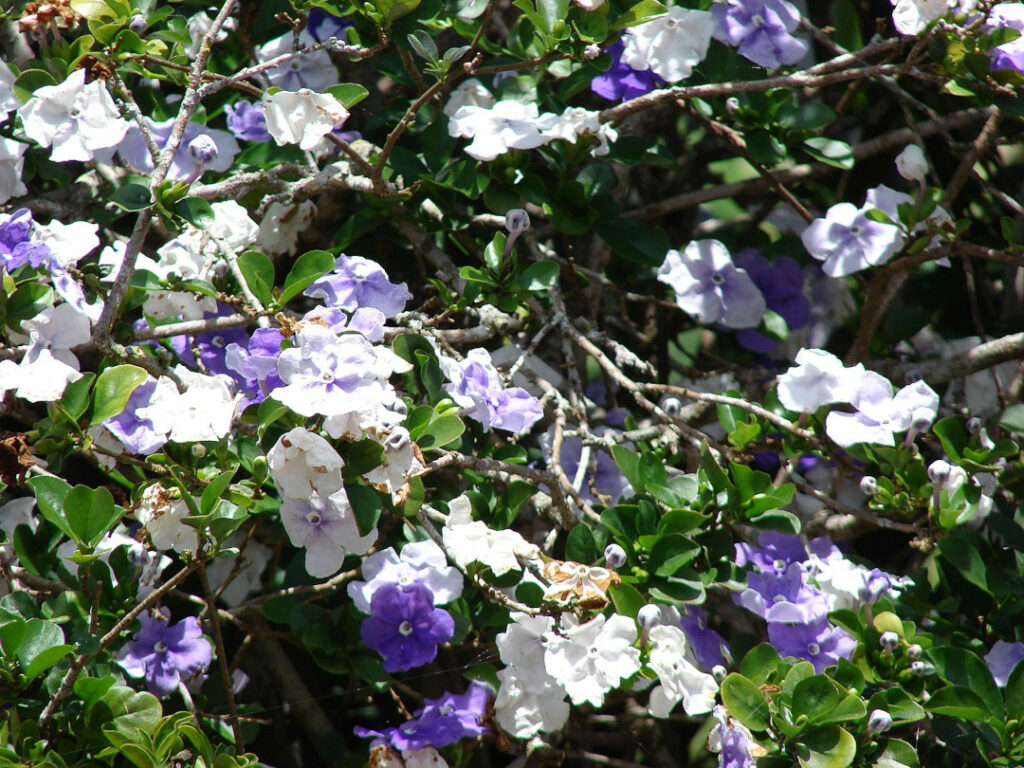
Paraguay
Paraguayan Jasmine
Brunfelsia australis

General Description/Cultural Significance
Paraguay lies in the center of Latin America, landlocked between Bolivia, Brazil, and Argentina. Despite its lack of coastline, water is a symbol of Paraguayan identity. The indigenous Guaraní word which the country’s name is derived from translates to the “river that gives birth to the sea.” The fertile lands nestled by these rivers allow plant life to flourish, including the wonderfully fragrant Paraguayan Jasmine.
Jasmine plants in Paraguay burst with flowers ranging in color from purple, to lavender, to white depending on their stage of blooming. The flowers change on an individual timeline, so the entire plant shows the range of colors during the blooming season. This visual range is why the shrub has been endearingly called the Yesterday Today and Tomorrow flower in Paraguay.
In addition to the beauty of jasmine’s colors and fragrance, it is a very useful medicinal plant. Indigenous Guaraní communities have used it as a treatment for commonly transmitted sexually transmitted infections such as syphilis for generations. Indigenous healers have also found it to be useful as a treatment for menstrual pain and that its roots have “analgesic, antispasmodic, sedative, central nervous system depressant, anesthetic… anti-inflammatory” and other uses.
Paraguayan Jasmine is a political symbol for revolutionary women, particularly referencing Juana María de Lara. According to regional mythology, upon the victory of the revolution she carried a bouquet of Paraguayan Jasmine, whose colors were the inspiration for an earlier Paraguayan flag. Historian Luis Verón described Juana María de Lara as “the representative of the feminine presence in those augural days of our Republic,” making Jasmine the symbol of that revolution and the role of women in its victory.
Climate Change/Conservation Status
Paraguay’s economy relies upon agriculture, energy, and transportation, all three of which are highly vulnerable to climate change impacts. The El Niño Southern Oscillation weather pattern has historically caused droughts and floods which were detrimental to the economy. These storms are expected to worsen in coming years due to climate change. These threats of climate change are worsened by the toxic waste dumping common amongst many industries in Paraguay such as tanneries. In addition, rising population growth has led to stress on the water supply and river systems. The Economic Commission for Latin America and the Caribbean predicts that in the projected scenario a 3.4-degree Celsius (6.1-degree Fahrenheit) rise in temperature will cause a loss of $9.7 billion to $50.5 billion by 2100. In other words, Paraguay is facing an annual loss of 2% of its GDP.
Those expected to be most affected by these climate change impacts are agrarian communities of small farmers, those living along rivers and floodplains, regions vulnerable to water scarcity, and cities prone to heat waves. Many of these groups are already financially vulnerable and contain majority indigenous communities.
The sweetly scented and colorful Paraguayan jasmine remains a symbol of revolution, the power of women, and indigenous healers. Hopefully, as the world takes more charge in fighting climate change, plant life such as Paraguayan Jasmine will be regarded as a vital part of ecosystems so that it can stay true to its nickname, Yesterday Today and Tomorrow, and its sweet floral and clove-like scent will remain for generations to come.
Alternate Names
Yesterday Today and Tomorrow plant
Morning Noon and Night plant
Eternity plant
Sources
Caribbean, E.C. for L.A. and the (2014). Climate Change Will Have Significant Impacts on Paraguay’s Economy. [online]
climateknowledgeportal.worldbank.org. (n.d.). World Bank Climate Change Knowledge Portal. [online]
Gilbert James Butland and John Hoyt Williams (2018). Paraguay | History, Geography, & Facts. In: Encyclopedia Britannica. [online]

